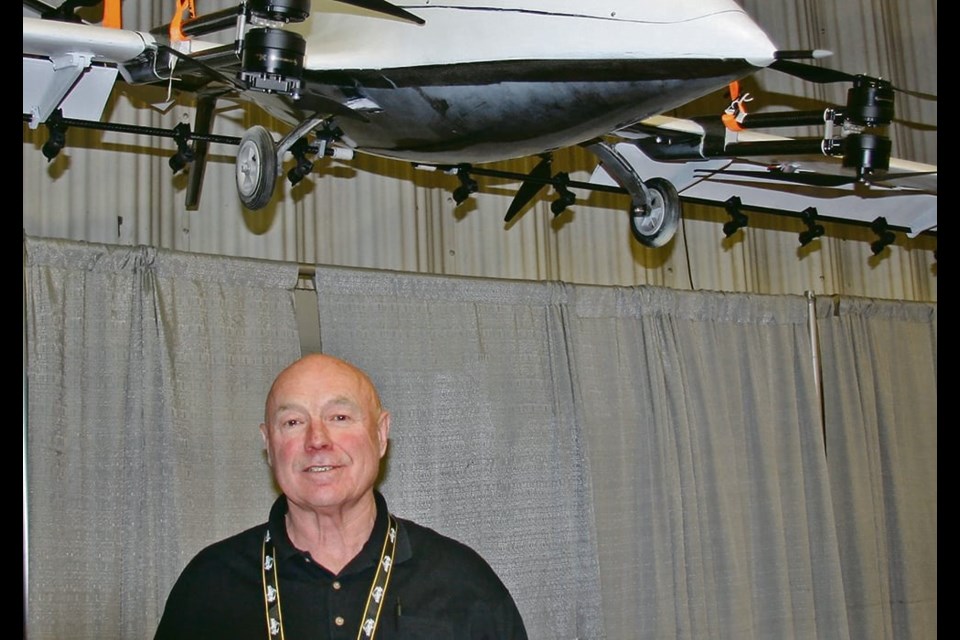BRANDON, Man. — Ag drones took a big leap forward (and upward) with the recent introduction of winged UAVs carrying 45 litres of product that can be precisely applied to a target.
Don Campbell had his demo drone suspended from the ceiling above his booth at Manitoba Ag Days. He said the ability to carry and apply crop protection products sets the new UAV generation apart from current ag drones that simply take pictures.
“When we started this project about five years ago, we first had to be licensed by the federal government,” said Campbell.
“We did a lot of research and looked at all the available spray drones. We finally decided on the ROGA U7AG, which is manufactured by Forward Robotics in Cambridge, Ont., and sold around the world. It’s purposely built for pesticide application.”
Most other spray drones are designed for low or ultra-low volumes of water, which does not ensure target efficacy. Campbell says the U7AG is designed to apply the correct label rates and regulations for pesticides. It sprays at one to three metres above the crop canopy at speeds up to 100 km/h with a 23-foot boom.
To reduce flow induced drift, the wings are designed with an ultra-high aspect ratio, winglets and laminar flow sections to reduce wing tip vortices and trailing edge turbulence.
“There is one key factor in ROGA productivity. Maximum spray time is achieved with an automated closed system refill station that refills in 60 seconds.
“Other companies swap out the battery when they come in for a fill. We don’t waste time doing that. We plug in a rapid recharge during filling. We want our drone up in the air as many hours as possible. It’s not making money sitting on the turf while you change batteries.”
Downtime for filling and recharge is in the range on one to two minutes. Although this seems like too little time for the battery, field testing has shown a one-minute recharge is enough to keep the ROGA working longer than needed to empty the spray tank.
There is a better than 1:1 ratio of spray capacity to battery capacity. At no time will the battery become so weak that it affects the digital systems.
“Over the course of a full day, by late afternoon, you won’t get a full recharge of the battery. It starts to wear down. You might get a 90 percent recharge. By the very end of the day you might have to stop for a while to do a full recharge. Or, it’s easy to install a fresh battery. Obviously, battery technology is the factor that has made all this possible.”
The ROGA design uses four electric motors. The two at the front always stay in the helicopter mode to provide vertical lift and control for takeoff and landing. The two larger motors at the rear are used in the takeoff and landing mode in the helicopter vertical lift position. Once airborne, they pivot 90 degrees to the rear to provide forward propulsion. When it’s time to land, they return to the helicopter position.
Campbell says the potential market for ROGA will be large farms that depend on high clearance sprayers, but need a small machine to attack isolated weed, insect and disease without putting tires in the field.
Another target market will be vegetable growers and other producers who grow high value crops.
“Some guys are talking to us about doing perimeters if they have flea beetle or grasshoppers moving in from the ditches.
“It’s valuable for growers who have odd-shaped fields where the big highboy booms just don’t fit. The drone can cover the perimeters and square up the field for the big machines.
“By now pretty well every farmer has learned about the economic loss they suffer every time they bring a high clearance sprayer into the field. We have a calculator on our website that lets you try different circumstances with sprayers in the field. You plug in your boom width and type of crop and the calculator will figure out the economic loss from tire trampling.
“At the moment we’re licensed to apply fertilizer and biological products. We aren’t’ yet licensed for chemical pesticides. Canada is the only county in world that hasn’t licensed drone application of crop protection products.
“PMRA (Pest Management Regulatory Agency) has been studying this issue. They have a lot of information on the table. It’s just up to them to pull the switch now.”
Campbell says commercial units should be available in Canada by this fall. List price will be $90,000.

